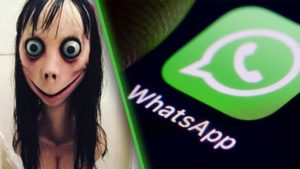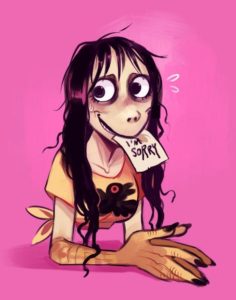Pop Culture dictionary
Momo Challenge
[moh-moh chal-inj]
What does the Momo Challenge mean?
Warning: this article contains references to suicide and other violent acts.
The Momo Challenge is a viral internet hoax that caused a worldwide panic in 2018–19. It involves a fake social media challenge in which a grotesque character, named Momo, is said to contact children on their cell phones or online, compelling them to commit violent acts, including suicide.
Where does Momo Challenge come from?

The Momo Challenge is named after Momo, an incongruously pleasant nickname for a disturbing statue of a bird-bodied women with bulging eyes and straggly hair.
The statue is called Mother Bird, created by Japanese artist Keisuke Aisawa in 2016 for a Tokyo art show. After it was exhibited, Japanese social-media users shared pictures of it. In 2018, a closeup picture of the sculpture was posted to the subreddit r/creepy, spreading images of the disturbing artwork—and its associated urban legend—around the world.
According to the legend (which appears to have initially spread on the Spanish-speaking internet), several phone numbers were at one point shared on social media. If a person used the messenger app WhatsApp to contact these numbers, they would get a reply from a user named Momo who used a photo of the Mother Bird statue as their profile picture.
This Momo would then command the person to complete a series of dangerous or violent tasks, such as stabbing people or committing suicide. Failure to complete them—in what became called the Momo Challenge by summer 2018—would result in threatening images or messages to the person. Despite how widespread accounts of the challenge were around the world, evidence for anybody chatting with Momo was either nonexistent or was only seen in clickbait YouTube videos of people being tricked by trolls.
The supposed Momo Challenge would have likely stayed just a creepy, if apocryphal, story if it weren’t for what now appears to be irresponsible journalism.
Shortly after the Momo Challenge legend started gaining steam online, an Argentinian girl committed suicide in July 2018. Investigating her phone, police reported she had been chatting on WhatsApp with another teenager. This teenager, according to police, attempted to convince the girl to commit suicide so they could film her death and credit the Momo Challenge for it. Despite the fact that the police clearly stated the suspect was likely trying to frame the fictitious Momo, some news stories, such as from the Buenos Aires Times, presented the Momo Challenge as the cause of the girl’s death.
Other suicides in various countries, from Colombia to India, were described in the media as victims of the Momo Challenge despite any definitive statements from police confirming the supposed challenge as a motivating factor. The Momo Challenge panic further intensified in 2018 thanks to news reports and videos, such as from Fox News that claimed, without evidence, the Momo Challenge was causing children to kill themselves. The reports also claimed that the Momo Challenge was being hacked into Peppa Pig videos on YouTube and on popular video games like Fortnite.
The panic around the Momo Challenge didn’t slow down in early 2019 thanks to yet more media coverage, this round spiking in the UK among schools and parents. But, in late February and early March 2019, journalists finally began reporting there was no evidence that any children’s videos had Momo Challenge footage spliced in. YouTube stepped in, confirming there was no evidence, especially after Kim Kardashian warned her millions of followers in February 2019 about Momo, urging the company to remove Momo Challenge videos from their site.
We want to clear something up regarding the Momo Challenge: We’ve seen no recent evidence of videos promoting the Momo Challenge on YouTube. Videos encouraging harmful and dangerous challenges are against our policies.
— YouTube (@YouTube) February 27, 2019
Police organizations in the US and UK also spread awareness that the Momo Challenge was a hoax so as not to encourage trolls or copycats that would threaten, harass, or scare children. And, in March 2019, the Mother Bird artist, Keisuke Aisawa, revealed that he had discarded the statue, as it had deteriorated and he felt partially responsible for the hoax and panic.
Examples of Momo Challenge

Who uses Momo Challenge?
By March 2019, the Momo Challenge is, fortunately, widely discussed as a hoax, urban legend, and moral panic, though the phenomenon is still causing concern among some schools and parents.
parents sharing posts about the momo challenge on facebookpic.twitter.com/L2OkNWGJNn
— nate (@euphtuft) March 1, 2019
Parents: Dont be doing that “momo challenge kids”
Kids after doin one challenge: pic.twitter.com/9ws5596XG9
— xLuiss 😛🐾 (@livinlikeluiss) March 4, 2019
When we find out whoever created that Momo challenge pic.twitter.com/5KV6nYsNUE
— OptiMystic 🇳🇬 🇦🇮 (@Thee_McNasty_) March 1, 2019
Instances of Momo Challenge also refer to various depictions (and celebrations) of the Mother Bird image, from tattoos to makeup tutorials.
Momo challenge tattoo #ohno #usawtfm pic.twitter.com/22janVYNEm
— U.S Army WTF! Moments (@TheWTFNation) March 5, 2019
In response to the Momo Challenge panic, the internet did what it does best: got weird and absurd. Memers responded to the Momo Challenge by spreading positive Momo memes and cute art of Momo.
Note
This is not meant to be a formal definition of Momo Challenge like most terms we define on Dictionary.com, but is rather an informal word summary that hopefully touches upon the key aspects of the meaning and usage of Momo Challenge that will help our users expand their word mastery.
